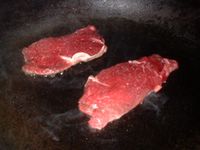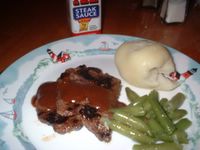 Using cast-iron skillet heated on high with 1 tbsp of oil, beef tenderloin takes only about 5 minutes per side to cook for well-done steaks. That's how my hubby likes it. For some who like it medium-rare it may take as short as 2 minutes.
Using cast-iron skillet heated on high with 1 tbsp of oil, beef tenderloin takes only about 5 minutes per side to cook for well-done steaks. That's how my hubby likes it. For some who like it medium-rare it may take as short as 2 minutes. Served while hot and juicy (overcooking will dry it up) with A-1 regular steak sauce, boiled veggies and boiled potatoes is how my husband prefers it. I can serve this to him anytime and expect a heartfelt thank-you kiss after the meal. This to him is the typical good American meal, which to most Filipinos would be considered good
 but expensive (beef is very expensive in the Philippines) and usually only available in high-class restaurants or hotels, not in wet markets where most Pinoys get their supplies of fresh meat.
but expensive (beef is very expensive in the Philippines) and usually only available in high-class restaurants or hotels, not in wet markets where most Pinoys get their supplies of fresh meat.Since my in-laws raise the cattle for our own yearly supply of beef, it is indeed the cheapest (and best considering that it is grass-fed and we know exactly how it was raised. This type of beef can command a high price if sold, and a lot of consumers concerned about the food they eat would grab at the opportunity to get a hold of this grass-fed cow even at a high price). We pay only $1 per pound to the butcher, no matter what cut (good steaks in the grocery stores can range from $4 to $8 per pound). The rest of the "cost" is into the labor we/my in-laws put into raising the cattle. Since we divide a whole cow into 1/4 (four families), we get to shell out only $250 per year for butchering. Not bad eh? However, for the whole year, from our share of the cow, we only get around 4 lbs of tenderloin steaks. So when we run out of tenderloins, I cook other steak cuts like porterhouse, t-bone, rib-eye, etc. I will post on how I prefer to cook these other cuts in the future. A related post about beef is found here. To know more about beef cuts, click here. (I noticed that I have rarely posted about these meals that are common in my kitchen now that I am where I am.)

I mentioned to my Filipino dr-friends here about our grass-fed cows and the benefits of eating grazing animals, as compared to grain-fed. They were very interested in buying if my in-laws would sell the beef. I talked recently with my in-laws. My brother-IL is taking over the herd, and they plan to sell, but the selling is by the half: 1/2 or 2 halves or 3 halves of the cow. Not 1/4 , not 20 pounds, etc. The cost would be, regardless of the cut, $1.75 per pound to my in-laws, $0.50/lb to the butcher (I think they might have had an arrangement with the butcher that by bringing him more butchering jobs, he lowered his labor costs), which will come to around $500 per half of the cow. Not bad, considering the quality of the meat and the price that is very competetive against those available in the grocery stores. But my brother-IL would be selling only 1 cow this year's fall (yes, there is that timing. Not this winter, spring nor summer.) . I hope more local farmers would go into that. Not only would it bring income to the local farmers and to the local community, it would also benefit the community in the fight against obesity and its complications (which we can now see as having its roots from the processed and refined foods that are so ubiquitous).
If you are also worried about the beef you buy from the grocery store, consider looking for a local farmer in your area who is also into the same kind of business. Not only are you using your money wisely, you are also doing your body a favor by giving it real good food. If you have no choice but to buy from the grocery stores, here's a good resource for guidelines.

1 comment:
What an informative post! It is kind of weird how we took these things for granted, but when I was growing up in the Philippines, this kind (grass fed) is the only kind of beef we had. My grandparents raised them and would butcher as needed.
Great idea about checking with local farmers, I never thought of that before. I'll have to look into it now.
Post a Comment